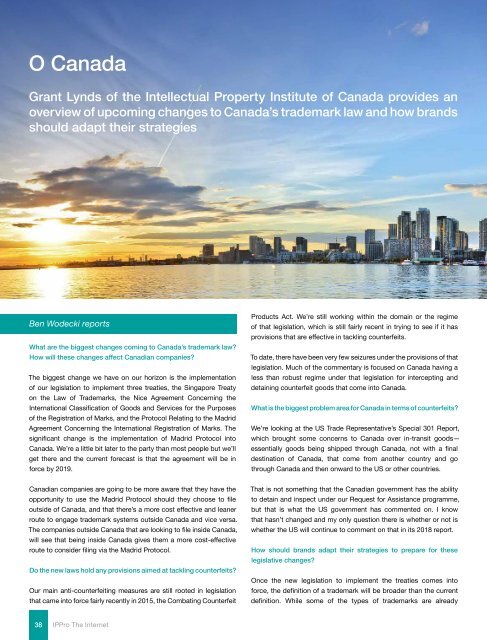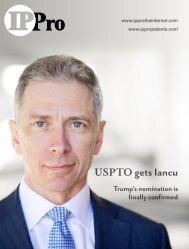IPPro Issue 002
IPPro is the go-to industry publication for news, views, and opinion on patent practice, law and management. The fortnightly publication and accompanying website - the only free-to-read intellectual property resource around - cover the full spectrum of IP law globally, including prosecution, litigation, licensing, management and technology.
IPPro is the go-to industry publication for news, views, and opinion on patent practice, law and management. The fortnightly publication and accompanying website - the only free-to-read intellectual property resource around - cover the full spectrum of IP law globally, including prosecution, litigation, licensing, management and technology.
You also want an ePaper? Increase the reach of your titles
YUMPU automatically turns print PDFs into web optimized ePapers that Google loves.
Country Profile<br />
O Canada<br />
Grant Lynds of the Intellectual Property Institute of Canada provides an<br />
overview of upcoming changes to Canada’s trademark law and how brands<br />
should adapt their strategies<br />
Ben Wodecki reports<br />
What are the biggest changes coming to Canada’s trademark law?<br />
How will these changes affect Canadian companies?<br />
The biggest change we have on our horizon is the implementation<br />
of our legislation to implement three treaties, the Singapore Treaty<br />
on the Law of Trademarks, the Nice Agreement Concerning the<br />
International Classification of Goods and Services for the Purposes<br />
of the Registration of Marks, and the Protocol Relating to the Madrid<br />
Agreement Concerning the International Registration of Marks. The<br />
significant change is the implementation of Madrid Protocol into<br />
Canada. We’re a little bit later to the party than most people but we’ll<br />
get there and the current forecast is that the agreement will be in<br />
force by 2019.<br />
Canadian companies are going to be more aware that they have the<br />
opportunity to use the Madrid Protocol should they choose to file<br />
outside of Canada, and that there’s a more cost effective and leaner<br />
route to engage trademark systems outside Canada and vice versa.<br />
The companies outside Canada that are looking to file inside Canada,<br />
will see that being inside Canada gives them a more cost-effective<br />
route to consider filing via the Madrid Protocol.<br />
Do the new laws hold any provisions aimed at tackling counterfeits?<br />
Our main anti-counterfeiting measures are still rooted in legislation<br />
that came into force fairly recently in 2015, the Combating Counterfeit<br />
Products Act. We’re still working within the domain or the regime<br />
of that legislation, which is still fairly recent in trying to see if it has<br />
provisions that are effective in tackling counterfeits.<br />
To date, there have been very few seizures under the provisions of that<br />
legislation. Much of the commentary is focused on Canada having a<br />
less than robust regime under that legislation for intercepting and<br />
detaining counterfeit goods that come into Canada.<br />
What is the biggest problem area for Canada in terms of counterfeits?<br />
We’re looking at the US Trade Representative’s Special 301 Report,<br />
which brought some concerns to Canada over in-transit goods—<br />
essentially goods being shipped through Canada, not with a final<br />
destination of Canada, that come from another country and go<br />
through Canada and then onward to the US or other countries.<br />
That is not something that the Canadian government has the ability<br />
to detain and inspect under our Request for Assistance programme,<br />
but that is what the US government has commented on. I know<br />
that hasn’t changed and my only question there is whether or not is<br />
whether the US will continue to comment on that in its 2018 report.<br />
How should brands adapt their strategies to prepare for these<br />
legislative changes?<br />
Once the new legislation to implement the treaties comes into<br />
force, the definition of a trademark will be broader than the current<br />
definition. While some of the types of trademarks are already<br />
recognised, even though they may not be explicitly identified in the<br />
definition of a trademark, the new definition will capture many forms<br />
of trademarks.<br />
Brand owners should review their portfolios to ensure they have<br />
captured all possible trademarks that may be deserving of protection<br />
in Canada.<br />
We also expect there may be increased opposition or summary<br />
cancellation proceedings in the future since trademark owners will<br />
not be required to provide evidence of use of their trademarks in<br />
order to obtain a registration.<br />
As such, if trademarks are registered in the future but use has<br />
not commenced within the requisite time period in Canada, we<br />
expect summary cancellation proceedings to increase as well as<br />
opposition activity.<br />
I think brand owners should therefore plan in their corporate<br />
strategies to engage Canada’s summary cancellation proceedings<br />
and opposition proceedings on an expanded basis, starting after the<br />
changes come into force, which we expect to be in 2019.<br />
What tools are available for Canadian brands looking to enforce<br />
their trademarks against counterfeits?<br />
Canadian brand owners can always look to sue for trademark<br />
infringement or passing-off in Canada’s Federal Court or provincial<br />
courts, and they can also try to engage the Request For Assistance<br />
process, which was brought into force by way of the Combating<br />
Counterfeit Products Act mentioned above.<br />
This is a procedure whereby brand owners can file a list of registered<br />
trademarks, geographical indications or copyrights with the Canada<br />
Border Services Agency (CBSA), to provide that information to the<br />
CBSA should they suspect incoming goods are counterfeit.<br />
There have been many recommendations by interested groups<br />
to the Canadian Federal Government on ways to improve<br />
the Request For Assistance process, which we hope will be<br />
addressed soon to improve Canada’s ability and reputation in the<br />
anti-counterfeiting regime.<br />
How might the renegotiation of the North American Free Trade Agreement<br />
(NAFTA) affect Canadian IP from an enforcement perspective?<br />
Both NAFTA and the Agreement on Trade-Related Aspects of<br />
Intellectual Property Rights (TRIPS) set minimum standards, which<br />
are often exceeded by either US or Canadian IP rights.<br />
As part of the NAFTA negotiations, the US has apparently been<br />
negotiating for a broader implementation of the enforcement<br />
provisions of TRIPS, but Canada has been focusing on modernising<br />
the language of NAFTA to reflect technological developments since<br />
the mid 1990’s.<br />
The enforcement of copyright in digital applications is one example<br />
where the US has been seeking tighter protection. <strong>IPPro</strong><br />
38 <strong>IPPro</strong> The Internet www.ipprotheinternet.com 39





